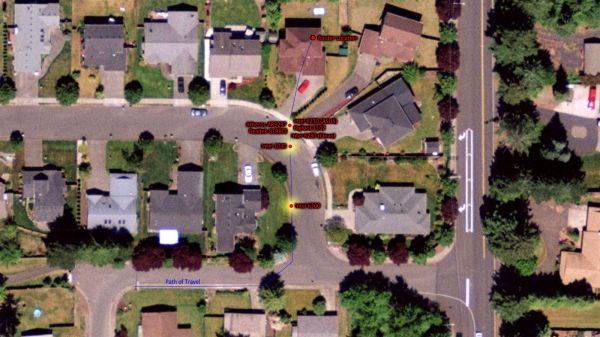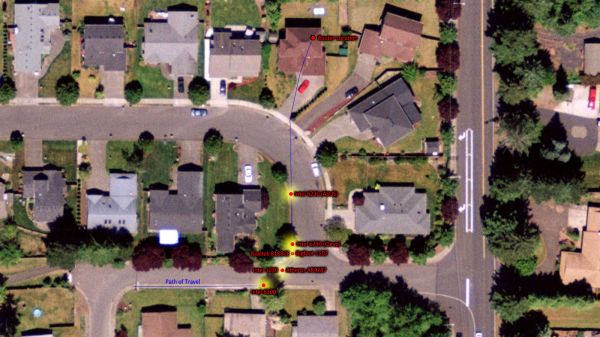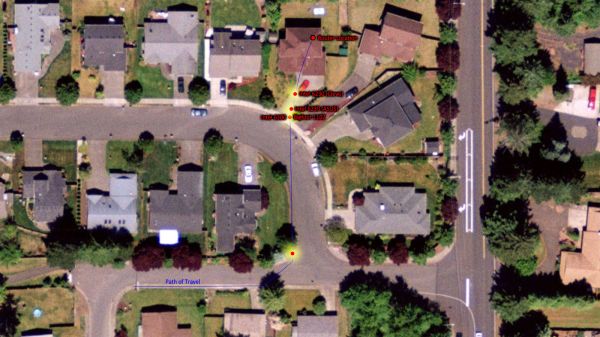Bigfoot’s Killer-N 1102 Wireless Networking vs. the World
by Jarred Walton on August 10, 2011 10:38 AM ESTTesting Signal Range
Throughput and latency are only two elements of wireless performance. Another important metric is how far a device can be from the router/access point before it drops the signal. For the Linksys E4200 router, we tested 2.4GHz and 5GHz performance with the other radio disabled (since we didn’t want the 5GHz capable laptops switching to 2.4GHz when the signal got weak). The routers were located in my office (one at a time) and I proceeded to walk out the front door with each laptop, closing the metal door behind me. It’s about 40 feet from the router to the front door (not in a direct line), and then I walked down the driveway and out into the street. I’ve created plots showing where I walked and how far I could go with each router and laptop combination. We’ll start with the Netgear results.
The vast majority of the laptops started having connection issues just past the end of my driveway. In fact, only two laptops did noticeably better, and one of those was only just barely better. The Intel 1030 maintained a connection about 20 feet further out than the other wireless devices, though throughput was understandably low (less than 5Mbps). The clear winner however is the Intel 6300. The third stream is almost certainly helping here with MRC, and perhaps the antenna and/or drivers have something to do with the performance as well. Regardless of the reason, the 6300 holds onto the wireless signal a good 60 feet farther than the 1030, and about 80 feet farther than the other wireless devices.
Moving to the Linksys E4200 and using the 2.4GHz radio, the results are substantially better than with the Netgear, thanks to a more powerful radio. Intel’s 6300 again goes the farthest before dropping out, reaching over 200 feet, likely thanks to the three spatial streams/antenna chains. The Atheros and Intel 1030 place second, just ~15 feet shy of the 6300, and Bigfoot’s 1102 and Realtek’s 8188CE are another ~15 feet behind the Atheros. Given the performance elsewhere, we weren’t particularly surprised to see Intel’s 6230 having the lowest coverage area, but it was a surprise to find that the ASUS K53E didn’t reach as far as the Clevo W150HR. Even though the K53E has worse coverage, keep in mind that it still works well in my entire yard and most of the neighboring houses—the latter point being good or bad, depending on whether you like sharing your wireless network.
When we shift over to a 5GHz signal, range drops significantly, providing even less coverage than the Netgear router. Higher frequency signals don’t propagate nearly as far, which can actually be beneficial for home environments—if all of my neighbors were using 5GHz wireless networks, I’d be lucky to see much less connect to any of them! This is one reason all the 5GHz capable cards perform so much better on a 5GHz network: lack of interference from neighboring networks (and microwaves, cordless phones, etc.). Of course, if you want a larger coverage area, even the worst result on 2.4GHz is about twice as far from the router as the best 5GHz result. Interesting to note is that in 5GHz testing, the Bigfoot 1102 actually has the best throughput out to near the end of my drive, pushing over 30Mbps until the last 5-10 feet. The cutoff point for 5GHz is really abrupt, and again that’s either good or bad depending on your intended use.
If reception at the limits of your wireless signal is important to you, the Intel 6300 appears to be the best bet (though potentially other 3x3:3 solutions might post similar results). However, we also need to consider throughput. Even though all of the devices technically maintained a 2.4GHz signal to the end of my driveway, I consider ~10Mbps of throughput to be the cutoff point for my purposes. In that case, right about where the red vehicle is parked is where I’d start getting irritated on the Netgear router, and maybe to the end of my driveway with the Linksys—except for the Intel 6300, which can go another 40 feet or so before dropping below 10Mbps. In general, even though some of the cards went farther before dropping the connection (or losing packets), throughput is much lower beyond the (metal) front door. All of the cards manage about 20-40Mbps inside the house, but close the front door and that quickly drops to 10-20Mbps. While that’s still faster than most Internet connections, latency starts to increase as well and periodic dropped packets become a concern.













52 Comments
View All Comments
Aikouka - Wednesday, August 10, 2011 - link
Jarred, if you asked me about a year ago... I never thought I'd recommend a Netgear product. My past encounters with their networking devices has been less than stellar. Even with that, I decided to take the plunge, and I purchased a WNDR3700 a few months back. It has treated me rather well so far and that's on stock firmware. It is DD-WRT compatible; so if you prefer their firmware, you're good to flash.Compared to the Airport Extreme, it is a bit weaker on the wireless front as it only supports MIMO 2x2, but its newer sibling, the WNDR4000, supports MIMO 3x3.
The one feature I'd definitely argue for though is simultaneous dual-band. I don't think most people have homes with only 5Ghz devices. So with just a dual-band router, you'd be limited to 2.4Ghz anyway.
xand42 - Wednesday, August 10, 2011 - link
Any idea why the (default parameter) netperf tcp transmit results are so horrible across the board? I just ran netperf on my Advanced-N 6200 notebook and got 190Mbit/s to my Cisco E3000 router, basically the same value as with iperf and netcat and every other benchmark.Rick83 - Wednesday, August 10, 2011 - link
It would be fairly interesting to see the difference between the Killer NIC, server NICs, laptop NICs and desktop NIC's from different vendors (and in different implementations).As I run only a SSD in my desktop, and have my user profile residing on a NAS (Intel i5 powered NAS, though, not limited by the available cycles and RAM) on a RAID 5, with reasonable linear throughput, network performance is quite important for me, as it accelerates such tasks as generating thumbnails of files, listing large directories, local decompression (that's probably the worst offender, and with large archives I do this on the NAS directly) and many tasks that access my user profile that may be latency or throughput limited.
For this reason I recently specifically got a mainboard with Intel network adapter, hoping for enhanced performance, but only realizing, that I'd have to hack the .inf to get driver support under my OS.
On the NAS, I am currently using the RTL 8111D chips, one connected to the switch and the other to the modem. If using a decent chip increases my samba/nfs performance, I'd put down the 50 euros for the intel pro chip in a blink.
Also you could test supported cable length, jumbo frame support, documentation (with some cards the maximum MTU is not properly documented, and it takes ages of non-fragmented pinging to discover the correct MTU) and performance of teaming and fail-over mechanisms.
Also, 5Ghz was something that I tried in my parent's home, but we couldn't even connect a machine that was one ceiling and wall away, at less than 10 meters distance. Might have been just a spectacularly bad router (Linksys 320N) or maybe 5GHz is really just for line-of-sight applications.
pityme - Wednesday, August 10, 2011 - link
Jarred,I think it would be nice to run tests of multiple wireless network interference like the kind observed in apartment/townhouse/condo situations. This is a big problem that no one seems to ever test/talk about.
ckryan - Wednesday, August 10, 2011 - link
True that. I live in a condo building in uptown Charlotte, NC and every unit has a wireless router of one kind or another. To make matters worse, the elevators seem to interfere somehow -- along with every wireless phone and microwave, the acres of glass and the steel structure. To top it off, there's an office building right next door which has many wireless systems on its own.ckryan - Wednesday, August 10, 2011 - link
Sometimes it seems like someone has cast some manner of evil voodoo on WiFi as a whole.I bought a Killer 2100 NIC because I thought it was a good idea -- and it was on sale. It is better than Intel's on-board Ethernet (and better still than Realtek) if only just barely. In reality, I just liked the idea of dedicated hardware for my networking needs. It really did make a difference, and really is some good stuff, but probably not worth the substantial premium over garden variety PCIe NICs (for most people). I'm glad I bought it... but only because it was on sale.
The Killer product line is in the position of having a product family which does perform mostly as advertised, but becomes a tough sell when you already have onboard ethernet or wifi. It has to be difficult to sell a consumer NIC that costs as much as a 80GB SSD or mid range video card. For $65 or $70 it's great. At $140, not so much. As such, I'm glad to see them trying to put their hardware inside other hardware, like networking cordon bleu. Shoving their "NPU" onto the PCBs of video and sound cards, motherboards, and laptops is a good idea and if nothing else add a little variety to the mix. It would easily be worth an extra $25 -$35 premium for a motherboard in any price range to get their NIC over the bog standard Realtek. It can't possibly cost more than the NF200 or Hydra chips on mid and high end mainboards and is surely worth an extra $20 on top of a laptop as well. Whether they can sell this particular device sans lappy at a reasonable price or even at all remains to be seen.
honvl - Wednesday, August 10, 2011 - link
I'm on a wireless card and want to test my latency. Where can I find this GaNE tool?Flunk - Wednesday, August 10, 2011 - link
This result really surprised me, I was expecting results like their wired products (no difference). My guess is that the biggest factor is the support for more channels but the performance really does seem markably better. I'm gearing up to by a new Alienware laptop near the end of the year and I may very well check the box for a Killer-N upgrade.StormyParis - Wednesday, August 10, 2011 - link
Isn't there a wide gap between what tech sites review, and what users use ? I know it's part of the purview of a tech site to go for the 0.001%-of-users, bleeding-edge stuff, but... has anyone ever seen a review of mainstream Wifi adapters/laptop anywhere ? As one of the 99.999%, I'd be interested !JarredWalton - Wednesday, August 10, 2011 - link
Bigfoot offered, so I thought, "Hey, this could be fun." Well, it wasn't. WiFi testing is a real pain in the butt I've decided. Still, it would be good to look at some other products. We might come back to the subject in the near future; I'm going to see about soliciting a bunch of different WiFi adapters and see what turns up. Obviously, I have at least the 6230 and 6300 from Intel. I want to add the Killer 1103, some Broadcom stuff, etc. Really, I'd want to focus on just dual-band cards, though -- anything that can't do 5GHz becomes less interesting after playing with the Linksys E4200.